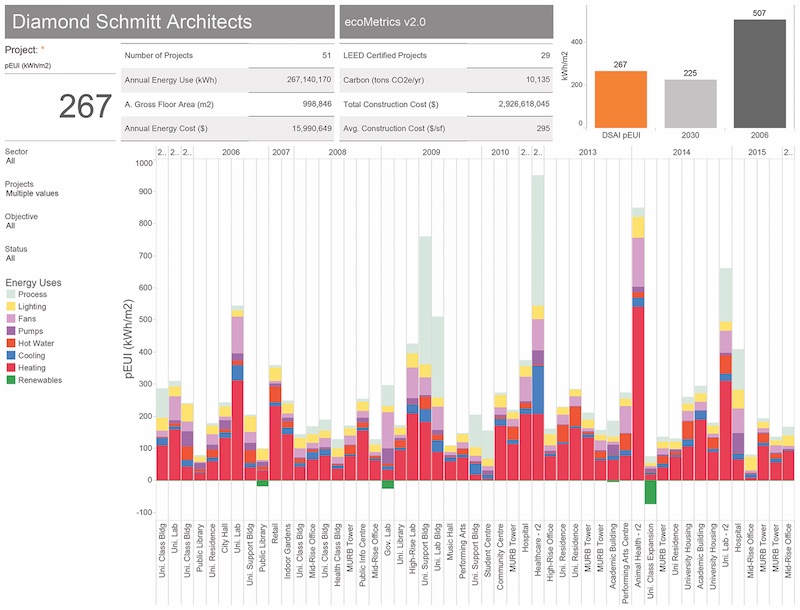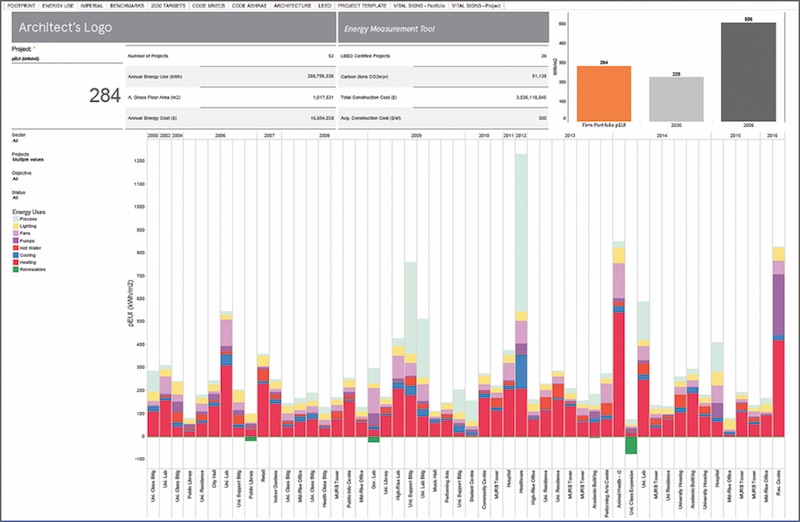Designers with Toronto-based Diamond Schmitt Architects (DSA) view building design and performance much like a physician views patient health: tracking the vital signs is key to developing the proper diagnosis or optimal solution.
Instead of using heart rate and blood pressure to identify concerns, DSA’s designers look at six key metrics that, when optimized, are likely to result in high-performance building design, even net-zero energy performance. These include: total envelope U-value, GFA-to-envelope ratio, outdoor air intake rate, heating efficiency, cooling efficiency, and internal heat gain sources.
To help its designers balance and optimize these metrics during the design phase, DSA created the ecoMetrics tool, a visual, interactive database of energy simulation models from 44 of the firm’s LEED-certified projects. The tool allows DSA team members to analyze the firm’s green projects in a consistent fashion. For example, by breaking down the predicted energy use for projects in kWhr/m2, designers can compare, in apples-to-apples fashion, past projects against current designs.
The database also presents project performance in relation to energy benchmarking systems, including LEED, 2030 Challenge, and energy codes. The goal, according to DSA, is to create a common language to more effectively engage clients, consultants, and project teams about energy reduction targets.
The tool was built using Tableau interactive data visualization software. DSA contracted Mike Williams, Associate with engineer RWDI, to assist with the coding and database creation.
“With ecoMetrics we are not only gaining a better understanding of energy use across different building types conveyed in simple-to-understand graphics, but also are driving innovation in sustainable design with this knowledge,” says Michal Szabo, Principal, DSA.

 The ecoMetrics tool breaks down each project’s energy simulation model by key performance metrics, including predicted energy use intensity, total envelope U-value, GFA-to-envelope ratio, outdoor air intake rate, heating efficiency, cooling efficiency, and internal heat gain sources.
The ecoMetrics tool breaks down each project’s energy simulation model by key performance metrics, including predicted energy use intensity, total envelope U-value, GFA-to-envelope ratio, outdoor air intake rate, heating efficiency, cooling efficiency, and internal heat gain sources.
Read about more innovations from BD+C's 2016 Great Solutions Report
Related Stories
Great Solutions | Aug 23, 2016
Biophilic pods beat the shade when it comes to outdoor cooling
The Xylem concept by CallisonRTKL regulates outdoor thermal comfort through shading, air movement, water circulation, and a vegetated roof.
Great Solutions | Aug 23, 2016
Mini-grant R&D program pays off in a big way for AE firm
Created through funding from Little’s LaceUp program, the Center for Building Performance has helped the design firm win 14 new jobs since its inception.
Great Solutions | Aug 23, 2016
At Beyer Blinder Belle everyone’s seeing RED
The firm’s R&D initiative inspires its designers to develop ideas that could positively disrupt the practice.
Great Solutions | Aug 23, 2016
Virtual care facility serves remote patients, may reduce readmissions
Mercy’s new high-tech medical center equips its medical professionals to deliver care at the bedside of patients anywhere.
Great Solutions | Aug 23, 2016
11 great solutions for the commercial construction market
A roll-up emergency department, next-gen telemedicine center, and biophilic cooling pods are among the AEC industry’s clever ideas and novel innovations for 2016.
Great Solutions | Jan 20, 2016
13 great solutions for commercial construction
As these 13 innovations for the AEC marketplace demonstrate, sometimes a problem can be a good thing.
Great Solutions | Jan 20, 2016
Digitally fabricated concrete formwork pushes the limits of what can be cost-effectively constructed in concrete
Simpson Gumpertz & Heger and CW Keller use 3D modeling and CNC machining to advance concrete construction.
Great Solutions | Jan 20, 2016
Sasaki Associates develops simple yet novel solution for precast concrete complication
Its double-angle cladding anchor maintains the air/water/vapor barrier integrity and continuous insulation while still allowing for the desired versatility of precast panels.
Great Solutions | Jan 20, 2016
Porcelanosa’s solid-surface product, Krion, used to create an elegant retractable ceiling for NY showroom
Typically used for countertops, vanities, and furniture, Krion was used to make 39 panels covering 1,300 sf of ceiling space above the showroom.
Great Solutions | Jan 20, 2016
Skanska’s new app helps construction teams monitor and meet environmental quality standards while renovating hospitals
App allows users to track noise, differential pressure levels, vibration, and dust

















